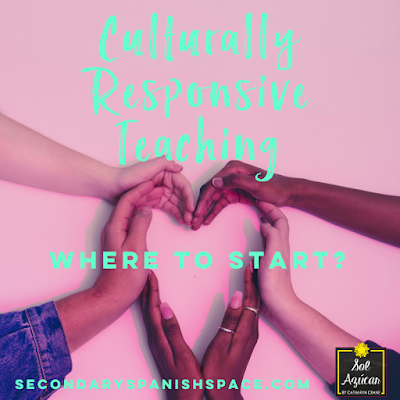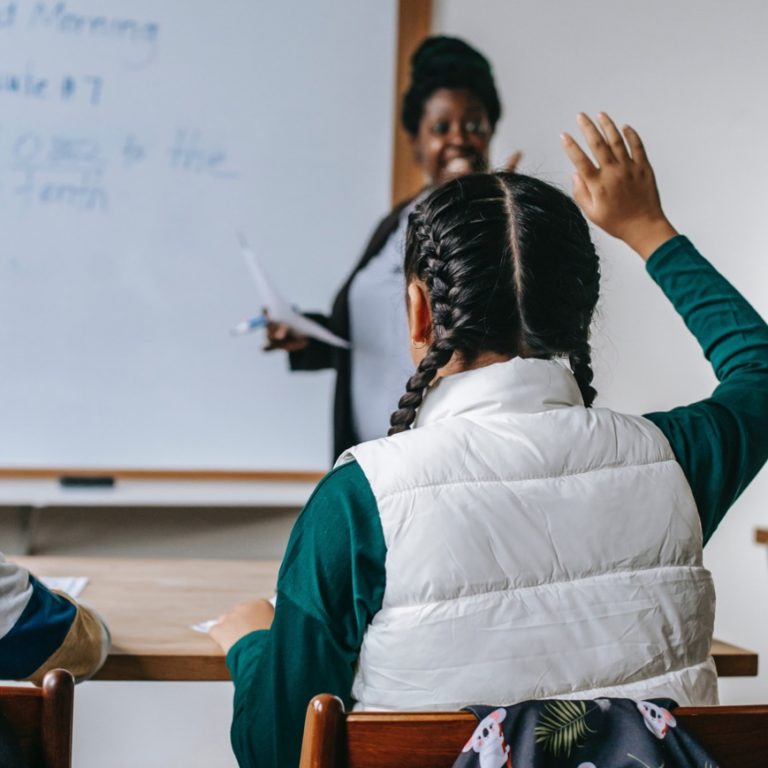December 11, 2018
By Catharyn Crane
Culturally responsive teaching is on my mind. Even during December, amidst Santa… finals… grading… projects… holiday band/orchestra/choir concerts… and weird scheduling… Culturally responsive teaching is always on my mind.
I hope it is on yours too. If it is not, here’s a post to get you thinking. If you’re too tired to think, book mark this page or pin it to your Pinterest board (or follow our Secondary Spanish Space Pinterest board and grab it later).
In this post, I’ll look at what exactly culturally responsive teaching is. Then I’ll think about how it can actually be implemented in the Spanish classroom. How can we Spanish teachers better understand and support our students who are part of traditionally marginalized or vulnerable groups (based on race, ethnicity, gender, culture, citizenship, income, language, disability, etc.)?
I have FIVE activity ideas that will help!
This topic is BIG. I am just starting to get my feet wet. So here are a few of my thoughts, no matter how incomplete they might be. I hope this gets you thinking more too.
Your Students’ Culture and Your Culture
I’m a white, female, college-educated teacher with blonde highlights. I drive an SUV, get Starbucks once a week, attend an occasional work out class, and watch documentaries on Netflix. Some of the high school Spanish students I used to teach did not look like me and did not remotely do any of the things I just described.
I taught at a big urban public high school. So some of my students came from backgrounds that were similar to me, and others had very different backgrounds. I’m sure this is true for you too, to some extent, even if you don’t teach at a big urban public school.
I had students who were of Native American descent, whose families didn’t speak English, who were experiencing depression, who were hoping to be the first in their families to go to college, etc., etc., etc.
Plus my students were surely dealing with other hidden challenges or experiencing other identities that I didn’t even know about.
I wasn’t blind to this, by any means, but I do think that over my teaching career there have been many times when I could have been more sensitive, empathetic, and thoughtful when it came to my underserved students. It is easier to figure out what kids “like me” needed. But what about kids not like me? There were times where I should have inquired more or tried to understand better. I absolutely should have been more patient and considerate of students’ challenging life circumstances. Quite simply, I could have been more responsive. More culturally responsive.
So how can we narrow that unintentional divide between our own culture and our students’ culture? Dr. Christopher Emdin of Teachers College Columbia has written a lot about the topic. He says that we can start becoming more culturally responsive by actively valuing our students’ communities, their ways of being, their unique expertise, their flair, their style, what makes them tick. Understanding our students’ hidden experiences, needs, and strengths is the first step to culturally responsive teaching.
Culturally Responsive Teaching
Culturally responsive teachers must understand that:
- Some of our students are marginalized due to their race, gender, sexual orientation, or other characteristics
- Some of our students do not have access to the social, emotional, and familial support that we have
- Some of our students experience hidden challenges that we will never know about
- Some of our students are more vulnerable than others because they are indigenous, non-native English speakers, LGBTQ Plus, or simply because they are female
- Some of our students get treated differently when they walk on the street than others do
- An “effective” learning experience for one student may not be “effective” for another
- Indigenous students
- Students of color
- Students experiencing homelessness
- Students from low-income families
- Students of undocumented immigration status
- Students with cognitive, physical, and/or emotional limitations
- English language learners
- Students who are gender non-conforming
- Students who are LGBTQ Plus
- Female students
A few years ago, a teacher friend of mine told me something like, “All that cultural stuff doesn’t really matter because I view each of my students as individuals anyway.” This rubbed me the wrong way. At the time I couldn’t articulate why.
Now I know it frustrated me because we teachers need to do much, much more than just treat each student as an individual.
I need to go above and beyond for my students who society has marginalized and continues to underserve. Education can be a great equalizer. But if I don’t do everything in my power to actually help my most vulnerable students succeed, they won’t.
The cards are stacked against them in so many ways. It is my job as their teacher to engage their unique interests, provide extra support (and different types of support too), to value their culture (and them), and to make them feel heard, seen, and felt.
Culturally Responsive Teaching in Practice
Idea 1: Student surveys
- By what name would you like me to address you?
- What are you hoping to get out of this class?
- Is there anything you’d like me to know about you? This is an opportunity to share any personal background or concerns, or to start a discussion about any accommodations you may need.
- What do you have going on this semester outside of school?
- How do you feel today in one word. Why?
- Do you have any questions for me at this time?
Idea 2: Classroom community building
One year, I had two African American students who would literally dance their way into my classroom every day. I have never danced my way into a classroom in my life. In school, I was the quiet white girl who slipped in the door, sat right down, followed all the rules without questioning, and rarely spoke in class. Looking back, I wonder what I could have done differently to be more responsive to those two dancing students. I always just smiled at them, and kind of ignored or passively accepted their grand entrance. What could I have done to actually embrace it? What could I have asked them to better understand why they came in this way? What could I have told them about my own experience as the quiet rule follower to help them also understand me and to make them feel safe to open up? How could I have modified learning activities to engage them better based on what I learned through these dialogues? Do you have any of your own “dancing students”? How can you start a dialog with them about what they value?
Idea 3: Student voice and choice
- What did you do this weekend?
- What do you like to do? What do you not like to do?
- Tell a story about your family / friends / home / school.
Idea 4: Look critically at your activities
Idea 5: Keep learning, discussing, and evolving as a culturally responsive teacher
Weigh In


















No Comments